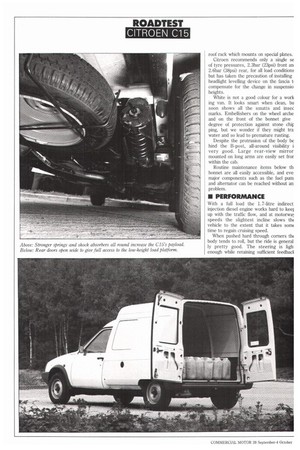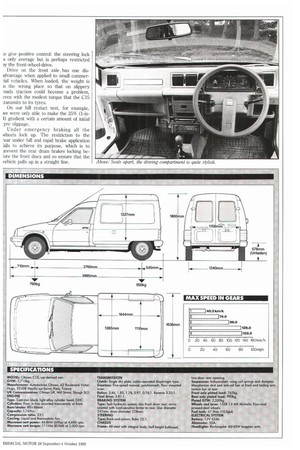ROADTEST CITROEN C15
Page 56

Page 58

Page 59

If you've noticed an error in this article please click here to report it so we can fix it.
With its increased payload capacity, new gearbox and attractive price. Citroen's uprated C15 diesel van could well increase its modest market share.
• Citroen's diesel-powered C15 van was something of a disappointment when it went on sale in the UK four years ago. Its generous volume of 2.63m3 put it ahead of other car-derived vans like the Maestro (2.43m3) or the Astramax (2.32m3), but a significant lack of muscle in the payload department dropped it back to the ranks of lightweights like the Renault Extra and the Fiat Fiorino.
But this latest model is a different proposition. It arrives with a restyled front end and, more importantly, beefier suspension which has increased its payload capacity by 190kg. The C15 will cheerfully carry 690kg against the Maestro's 700kg allowance and the Astramax's 635kg. Combined with the superior volume and its substantially cheaper price at £5,638 about £1,000 less than the others — this is bound to win the Citroen some new friends.
Even without the extra capacity the C15 has proved very competitive in Europe, where it has taken about 14% of the car-derived market — second only to the well-established Renault Extra. Its fortune in the UK has been less marked, with only a 3% share, and its hitherto limited payload must be partly to blame for that.
Along with the heavier shock absorbers and springs and slightly more efficient brakes, the C15 has gained a five-speed gearbox. Because of this and in spite of a 12% increase in gross weight, its fuel consumption of 6.97 litilOOkm is only 0.5% higher than we achieved over our light van route with the original model (CM 16 Nov 1985).
Body styling does little to assist fuel economy or high-speed performance. The new front end, with larger bumper, wheel arch embellishers and smaller grille, clearly conforms to the design of the Citroen Visa car from which the van is derived. Behind the driving compartment the body line changes abruptly to make room for the large volume cargo area. In dry weather, fly-spotting on the vertical panels around the rear of the cab bears witness to the air turbulence around this area.
Inside, the vinyl seats are sweaty, uncomfortable pieces of furniture. No one would think of specifying this material for office furniture, so why impose it on the poor van driver? Behind the seats the half-height bulkhead restricts adjustment, making leg-room cramped. This is made worse by a high pedal cluster.
Four air vents mounted in the fascia have separate directional controls. Heating and ventilation controls are located centrally, and are simple and easy to use. There is a neatly laid-out and compact instrument binnacle in front of the singlespoked steering wheel and a small but useful glove box on the other.
Additional storage space is restricted to two small shelves fitted below the fascia and a small oddment tray in the central console. Thick rubber mats in the footwells are fitted loosely so that they can easily be removed for cleaning.
Roof lining extends back to the start of the load area, where a pressed-steel half bulkhead extends the full width of the driving compartment to close off the load platform. This seems to be a good idea and one many more manufacturers should follow, but it does need to be stronger if it is to withstand the weight of the load under braking.
Our test vehicle was fitted with a body liner — a smart accessory which protects the body panels up to waist height — but its smooth surface offered little grip, so we added a thin rubber-weave mat. This stopped the load from shifting during nor mal driving. The liner proved difficult to remove, as it fits tightly. At the rear, however, it needs to be relieved to give clearance for the spare wheel carrier retention bolt.
The twin rear doors open to a full 180' (if the wire stays are released) to give clear access to the low load platform. Narrow wheel'arches intrude slightly into the floor area, but do not significantly restrict the load area.
The side walls narrow slightly towards the roof, while the full-height doors curve over along the top edge so that when shut, they cover a drainage channel along the rear edge of the roof which prevents rain water running inside.
If more space is needed than is available inside, Citroen offers a heavy-duty roof rack which mounts on special plates.
Citroen recommends only a single se of tyre pressures, 2.3bar (23psi) front an 2.6bar (38psi) rear, for all load conditions but has taken the precaution of installing headlight levelling device on the fascia t compensate for the change in suspensio heights.
White is not a good colour for a work ing van. It looks smart when clean, bu soon shows all the srnutts and insec marks. Embellishers on the wheel arche and on the front of the bonnet give degree of protection against stone chip ping, but we wonder if they might tra water and so lead to premature rusting.
Despite the protrusion of the body be hind the B-post, all-around visibility i very good. Large rear-view mirror mounted on long arms are easily set fror, within the cab.
Routine maintenance items below th bonnet are all easily accessible, and eve major components such as the fuel purn and alternator can be reached without an problem.
With a full load the 1.7-litre indirect injection diesel engine works hard to keel up with the traffic flow, and at motorwaj speeds the slightest incline slows th( vehicle to the extent that it takes som( time to regain cruising speed.
When pushed hard through corners th( body tends to roll, but the ride is general ly pretty good. The steering is ligh. enough while retaining sufficient feedbacl
:o give positive control: the steering lock s only average but is perhaps restricted )y the front-wheel-drive.
Drive on the front axle, has one disxlvantage when applied to small commerial vehicles. When loaded, the weight is n the wrong place so that on slippery roads traction could become a problem, :.ven with the modest torque that the C15 :ransmits to its tyres.
On our hill restart test, for example, we were only able to make the 25% (1-in!) gradient with a certain amount of initial :yre slippage.
Under emergency braking all the wheels lock up. The restriction to the rear under full and rapid brake application :ails to achieve its purpose, which is to 3revent the rear drum brakes locking be'Ore the front discs and so ensure that the vehicle pulls up in a straight line.














































































































